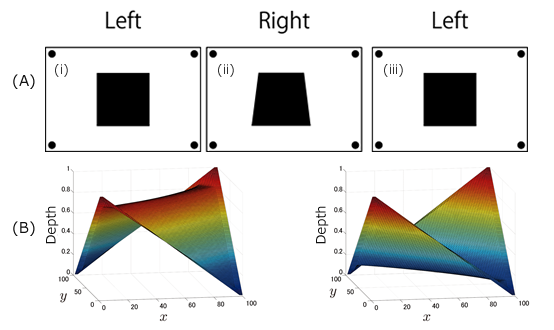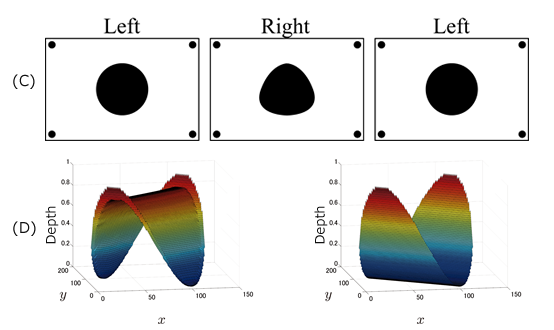September 2014 Issue
Research Highlights
Depth perception - understanding ambiguities
Binocular vision allows us to gauge depth. For example a dot directly ahead of the left eye will be at an angle to the right that decreases with distance. So how, ask Eiichi Mitsukura and Shunji Satoh at the University of Electro-Communications in Tokyo, can we estimate the depth of black or white paper? With no pattern or texture on the paper there should be no way of determining its contours. They turned to the computational tools used for filling in blind spots for an answer.
The visual system fills in blind spots much like art restorers touch up paintings. Extrapolating surrounding areas can be used to fill in missing areas and algorithms have been devised from this intuitive principle for filling in missing parts of digital images.
In previous work Satoh expanded on the intuitive descriptions for filling in gaps in images using mathematical descriptions for images based on contours and flow lines [1]. Their curvature, bias and divergence can be used to develop an algorithm for filling in blind spots that is in fact similar to those that describe physiological processes in the visual system as developed based on observed neural properties and mechanisms.
In a recent paper Mitsukura and Satoh apply similar mathematical descriptions used for blind spot image in-filling, to fill in depth details [2]. Similar to the human visual system, the model successfully distinguishes folds from curves.
- Satoh S Computational identity between digital image inpainting and filling-in process at the blind spot. Neural Computing and Applications 21, 613-621 (2012) doi: 10.1007/s00521-011-0646-y
- Mitsukura E & Satoh S Computational study of depth perception for an ambiguous image region: How can we estimate the depth of black or white paper? M. Lee et al. (Eds.): ICONIP 2013, Part III, LNCS 8228, pp. 225-232, 2013. (Springer-Verlag, Berlin Heidelberg, 2013)
The researchers have developed a model that can fill in depth details for ambiguous areas such as a sheet of paper. These are results from the proposed model using different initial conditions.




